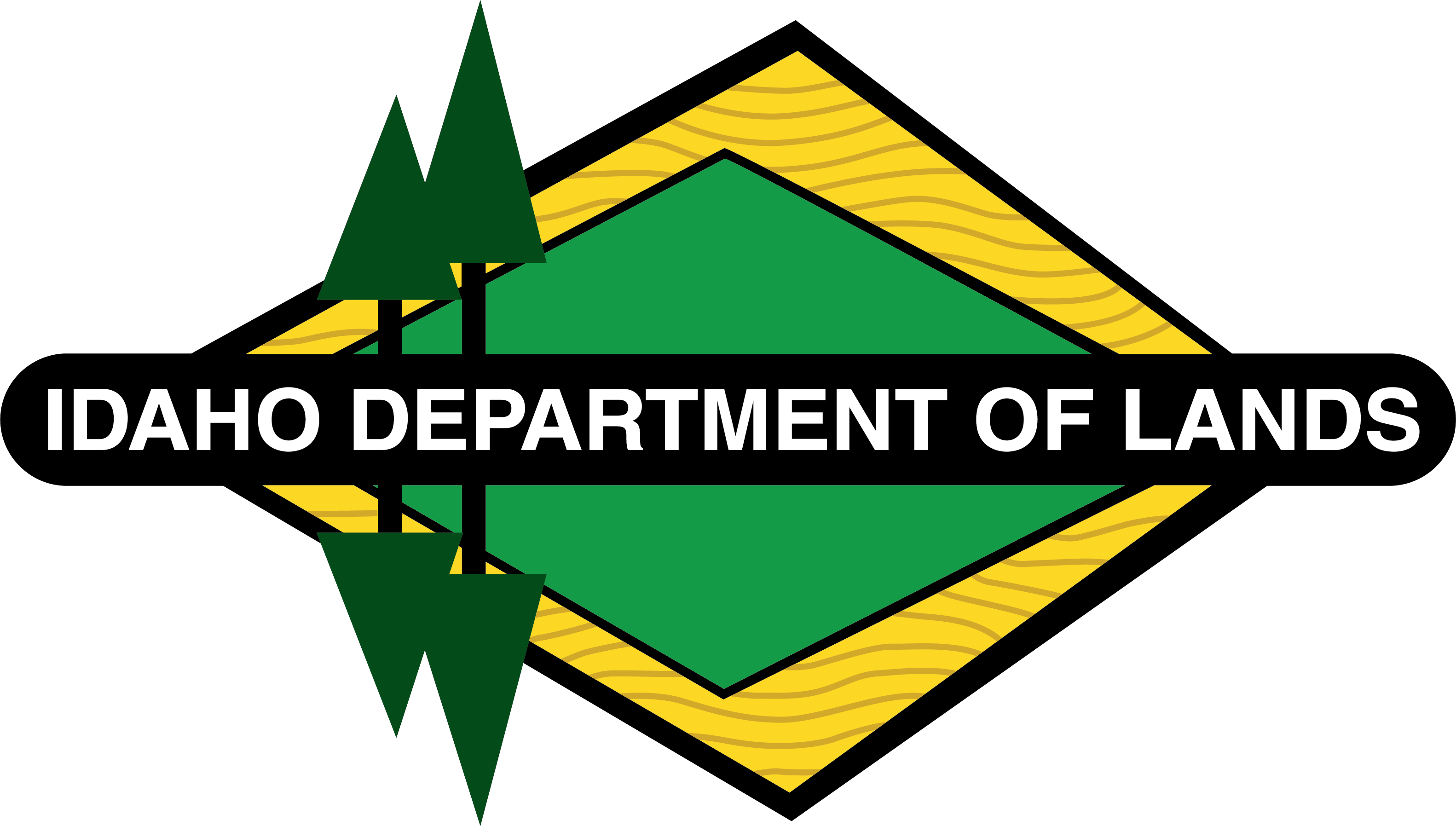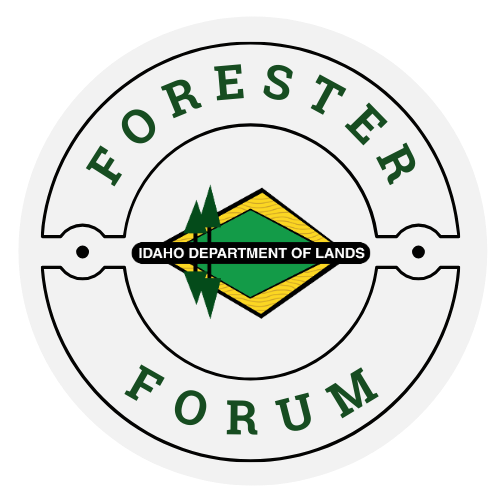Category: Forestry
Forest Management 8: Summary of Cost Share Programs
Nominations open for Forest Practices Advisory Committee
(COEUR D’ALENE) – The Idaho Department of Lands (IDL) will accept nominations for two positions on the Idaho Forest Practices Advisory Committee (FPAC) through the close of business on October 31, 2021.
Charged by state law with selecting the committee members, IDL director Dustin Miller will appoint qualified individuals to serve three-year terms for the Operator North and General Public Representative South positions. The current appointments for both positions expire on December 31, 2021.
“Applicants must be Idaho residents qualified through experience or training to provide technical advice on forest practices,” said Miller. Organizations or individuals interested in nominating a candidate must send a short biography and description of the nominee’s forest practices related experience/training to Gary Hess, IDL Forest Practices Program Manager via mail or email to:
Gary Hess, IDL Forest Practices Program Manager
3284 W. Industrial Loop
Coeur d’Alene, ID 83815
ghess@idl.idaho.gov
“FPAC provides technical assistance to the Idaho State Board of Land Commissioners in matters relating to the Idaho Forest Practices Act and typically meets two or three times per year, depending on current issues,” added Miller.
Per Idaho Code, FPAC includes nine voting members: a fisheries biologist; three private forest landowners who regularly engage in forest practices (one from north Idaho, one from south Idaho and one nonindustrial); two forest practice operators (one north and one south); and three representatives of the general public (one north, one south and one at-large).
More information about FPAC is available online at https://www.idl.idaho.gov/forestry/forest-practices-act.
Idaho Department of Lands Firefighters Stop 90% of Fires at 10 Acres or Less
(Boise) – Idaho Department of Lands (IDL) firefighters have already responded to 99 wildfires that burned 433 acres on state and private lands protected by the Idaho Department of Lands. The department provides fire suppression and prevention on more than 6 million acres of state and private forests and rangelands across Idaho.
IDL firefighters and crews from the Clearwater-Potlatch Timber Protective Association and Southern Idaho Timber Protective Association have held 90 of those fires to less than 10 acres, with many of the fires contained at less than an acre.
This hard-hitting initial attack is crucial in a year where, according to National Interagency Fire Center meteorologists, 80% of Idaho is currently in drought and the rest of the state will likely be in drought in the next several months. Controlling fires quickly, before they grow, saves valuable natural resources and tax dollars.
“It’s early in the fire season, and we’ve already seen three times as many acres burned this year over the 20-year average,” said Josh Harvey, IDL’s Fire Bureau Chief. “Unfortunately, 95% of these fires were human caused and could have been prevented. We are ready to suppress fires, but we need the public to help us by not starting wildfires.”
The number of fires to date and drought conditions indicate the 2021 fire season may be a very challenging.
###
Media Contact: Sharla Arledge | PIO | 208-334-0286 | pio@idl.idaho.gov
Idaho’s State Forester to speak before Congressional Committee on Natural Resources
(Boise) – Idaho’s State Forester Craig Foss will discuss the relationship between drought, wildfires and forest health before a House Committee on Natural Resources subcommittee on Tuesday, May 25, 2021 in Washington D.C. Representative Russ Fulcher (R-ID) invited Foss to speak before the Western Drought Forum titled, “The status of drought conditions throughout the western United States.”
Idaho’s national forests comprise 80% of the state’s total forestland. Of federal forestland suitable for management, more than 8 million acres are in declining condition, leaving them at high risk of insect and disease and wildfire mortality.
As State Forester with the Idaho Department of Lands, Foss oversees the forestry and fire programs for the state of Idaho. Foss will share about Idaho’s efforts and goals through Shared Stewardship and Good Neighbor Authority agreements to double the number of acres treated and restored on our most at-risk federal forestlands. Adjacent state, industrial and family forestland will also be treated, assuring landscape-scale forest health improvements.
“Managed forests are healthy forests, better able to withstand wildfire, pests, and drought, and more capable of storing carbon, providing clean air, water, wildlife habitat, economic and recreational opportunities, and countless other benefits,” Foss said. “Forests, water and people are dependent on one another.”
Foss says it will take many years to address the extensive work needed to restore forested watersheds in Idaho and throughout the west. Foss will stress the need for consistent national policy support.
“It will require increased funding for climate change research, active forest management, wildfire mitigation, increased use of prescribed fire and reforestation,” said Foss.
The subcommittee meeting will be held Tuesday, May 25, 2021 at 11 a.m. MST. (1 pm EST) and can be seen at https://naturalresources.house.gov/hearings/remote-wow-oversight-hearing_may-25-2021.
# # #
Media Contact: Sharla Arledge | PIO | 208-334-0286 | pio@idl.idaho.gov
Beware: Burn piles from the fall may go into flames
(Coeur d’Alene) – Every fall, many forest landowners gather up branches/slash from logging activities and burn large piles. However, some make the mistake of assuming that the fire is completely out, when in fact the remaining unburned material may smolder for months under winter snow.
It is extremely important to be sure your pile is out: Go back and check the piles for heat. The pile must be cold to the touch. Large piles of unburned material may need to be moved around to ensure the fire is completely out. Remember, people may be liable for the cost of fire suppression if their fire gets out of control.
Already this year there have been reports of those still-smoldering piles catching flame. That, combined with unusually dry conditions for this time of year, is creating a serious wildfire risk with fires already occurring as a result.
More about at-risk piles: Large piles of tree materials that were pushed together by bulldozers or other types of equipment are especially at risk of smoldering and catching flame because the dirt and rocks may cover partially-burned tree material, allowing it to smolder without visible evidence. Snow cover can further insulate the pile, creating a slow-cook heat within the pile. Once the snow melts and the material dries out, the smoldering heat can catch flame and spread to other areas. The attached photos from this spring near Bonners Ferry in North Idaho are examples.
If you are doing any burning: Burn permits are required May 10 – October 20 each year. They are free. They are not required for campfires.
Who needs a permit: Idaho law (38-115) requires any person planning to burn outside city limits within Idaho, including crop residue burning, to obtain a state burn permit during this period, referred to as closed fire season. A burn permit must be obtained before starting debris burning activities and you must have it with you when burning. Other laws related to open burning in Idaho also apply. Permits are free and good for 10 days. Campfires do not require a burn permit.
How to get a burn permit: Visit the self-service website burnpermits.idaho.gov. Permits are available seven days a week and are immediately issued and valid. No matter where you want to burn and what you plan to burn, the system will either issue you the burn permit you need on the spot or tell you which entity to contact for alternate or additional permits. A permit may also be issued by your local IDL office.
About IDL Fire: Idaho Department of Lands Fire Management (IDL Fire) in partnership with two Timber Protection Associations and with the support of rural volunteer fire departments and other partners, are responsible for fire suppression and prevention on more than 6 million acres of state and private forests and rangelands in Idaho. IDL Fire focuses on initial attack with the goal of keeping fires at 10 acres or less. IDL Fire protects and preserves important endowment timber assets that help fund Idaho schools and other beneficiaries, as well as millions of acres of private forestland.
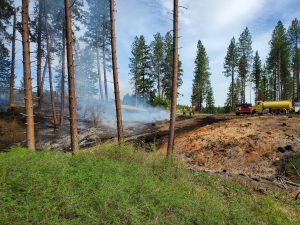
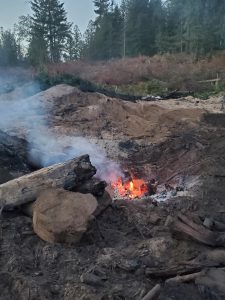
Media Contact
Robbie Johnson
Idaho Department of Lands
Public Information Officer
pio@idl.idaho.gov
208 908-1786
Negotiated Rulemaking for Forest Practices
(Boise, Idaho) Rules for harvesting timber next to fish bearing streams may soon be easier to understand and follow. Idaho Department of Lands (IDL) will hold negotiated rulemaking for the Rules Pertaining to the Idaho Forest Practices Act. Two rules are recommended for revision to simplify implementation and to account for updated forest management technologies. Rulemaking allows forestland owners, industry, and other members of the public to participate.
The rulemaking will be conducted in accordance with the Governor’s Executive Order 2020-01, Zero-Based Regulation. Unnecessary rule language is proposed for removal, specific rule language is recommended to reduce verbiage and improve readability.
The current Shade Rule went into effect in 2014 and was established to protect the shading of fish bearing streams when timber is harvested. A study on the effectiveness of the rule was completed last year and showed the desired shade levels were being achieved. However, the rule is considered by many to be too complicated with numerous opportunities for error.
The Idaho Forest Practices Advisory Committee (FPAC) recommended language refining the definition of class one streams and simplifying the rule to promote rule understanding, make compliance easier and less costly, while maintaining the effectiveness of the rule. At this point, the rule verbiage has gone from about 492 words to 100.
FPAC also identified a need to update rules specific to the use of ground-based equipment on steep slopes. Technology used in the industry has changed; machinery is now being used on steep slopes while tethered to an anchor with a specialized winch to improve traction. This traction-assistance allows the machine to operate safely on steep slopes while minimizing soil disturbance. Existing rule language does not allow for universal use of this new family of machines; modified rule language is needed to accommodate changing technology.
The rules will now go through a negotiated process with additional input. The following public meetings have been scheduled and the public may join in person, by telephone or by Zoom web conference.
Wednesday, April 14, 2021
6 – 8 p.m. (PT)
Best Western Plus
477326 Highway 95
Ponderay, ID 83852
Thursday, April 22, 2021
6 – 8 p.m. (PT)
Best Western Plus
506 W Appleway Avenue
Coeur d’Alene, ID 83814
Thursday, April 29, 2021
6 – 8 p.m. (PT)
Best Western Lodge at River’s Edge
615 Main Street
Orofino, ID 83544
Tuesday, May 4, 2021
6 – 8 p.m. (MT)
Holiday Inn Express & Suites
210 N 3rd Street
McCall, ID 83638
For more information about these or additional meetings that may be scheduled, visit the IDL website at: https://www.idl.idaho.gov/rulemaking/docket-20-0201-2101.
IDL administers the Idaho Forest Practices Act (Title 38, Chapter 13, Idaho Code), which sets standards for logging, road building, reforestation, streamside protection, and other forest activities. The Rules Pertaining to the Idaho Forest Practices Act set minimum standards to assure the continuous growing and harvesting of forest tree species and to protect and maintain the forest soil, water resources, wildlife, and aquatic habitat.
The Idaho Forest Practices Advisory Committee (FPAC) provides technical assistance to the IDL and the Land Board in matters relating to the Idaho Forest Practices Act and its rules. FPAC is made up of nine voting members from across the state representing family forest owners, industrial forest owners, logging operators, general forest practitioners, and fisheries biology. There are also ex officio members from other state agencies and technical specialties.
# # #
Media Contact: Sharla Arledge | PIO | 208-334-0286 | pio@idl.idaho.gov
Contact: Gary Hess | Regulatory & Stewardship Program Manager |(208) 666-8636 | ghess@idl.idaho.gov
Come spring, bark beetles may attack trees damaged in winter storms
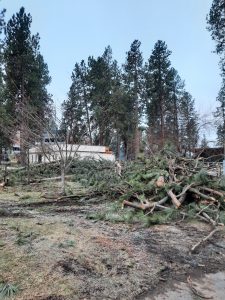
(COEUR D’ALENE) – Damaging winter storms across northern Idaho this season mean forested areas are more susceptible to infestations of certain bark beetles this spring. Photo by JD Reeves.
Idaho Department of Lands (IDL) forest health officials want forest landowners to know that trees uprooted or broken during storms can become infested by bark beetles as the weather warms. The beetles can build up populations in fresh, damaged logs and then attack and kill neighboring healthy trees. However, taking certain steps can minimize the damage.
The risk of bark beetle attack and the recommended management actions differ depending on which tree species has been damaged. The size of damaged trees also impacts their susceptibility to bark beetles. Dead trees are not at risk for infestation, only green trees and logs damaged within the past winter are cause for concern.
Pines and pine slash larger than three inches in diameter can be infested by the pine engraver beetle (Ips beetles). Pine engraver beetles infest wind-thrown trees and slash in April and May, laying eggs that develop into adults and emerge in June of the same year. Beetles that emerge in June often attack adjacent live pines.
Douglas-fir, particularly large-diameter logs, can be infested by Douglas-fir beetle. Beetles infesting damaged Douglas-fir in the spring will produce offspring that take a year to develop, emerging to attack additional Douglas-fir trees in the spring of 2022. Down, large-diameter western larch are also susceptible to attack by Douglas-fir beetle, but live, standing larch are rarely attacked.
Engelmann spruce can be infested by spruce beetle, especially if logs are large-diameter. Spruce beetles take one or more years to develop, depending on temperature, before emerging to attack additional standing spruce trees. Spruce beetles can attack ornamental species like Norway or blue spruce, but these are infrequent hosts.
These bark beetle species are highly attracted to the moist tissue under the bark of wind-thrown trees, broken tops, and logs.
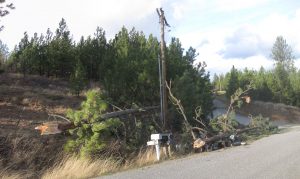 The best option to reduce beetle infestations is to remove damaged trees. If there are not enough trees to economically salvage, consider safely burning or chipping, or removing branches and cutting green logs into smaller pieces. If chipping in spring, do not pile chips near the base of standing trees since their odors can be attractive to bark beetles for a short period of time. Spread chips out in the sun, or chip in late summer or fall if possible.
The best option to reduce beetle infestations is to remove damaged trees. If there are not enough trees to economically salvage, consider safely burning or chipping, or removing branches and cutting green logs into smaller pieces. If chipping in spring, do not pile chips near the base of standing trees since their odors can be attractive to bark beetles for a short period of time. Spread chips out in the sun, or chip in late summer or fall if possible.
Forest owners can hasten the drying of logs and green wood by spreading them in a sunny area before beetles fly in the spring. Leaving damaged trees or decks of green logs in shady areas increases the chances that they will be infested. DO NOT stack green firewood next to live standing trees. The idea is to reduce the number of places for the damaging beetles to breed and then kill live trees.
In pines, quick action is necessary since beetles can emerge from damaged pine materials as early as June, 2021. Large-diameter logs of Douglas-fir, western larch, and spruce will not pose a threat until spring, 2022. These logs can be bucked and split this spring or summer and left to dry out and kill any developing beetles before they emerge next spring. Infested materials can also be removed, chipped, or burned during the winter of 2021-2022.
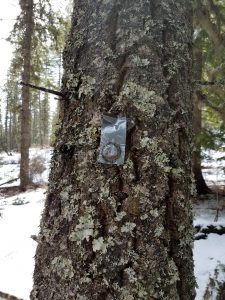 Pheromone repellent pouches called MCH are an additional tool to ward off Douglas-fir beetle. These pouches can be stapled to susceptible down logs in April, 2021, and will prevent infestation by Douglas-fir beetle by tricking beetles into thinking the logs have already been fully attacked. If down logs cannot be treated this April and become infested, surrounding stands can be protected with MCH applied to nearby standing trees in April, 2022. MCH is very effective at protecting Douglas-fir trees, but it will not work to protect pines and has limited effectiveness in protecting spruce. For additional information about using pheromones, please contact the IDL forest health team at (208) 769-1525.
Pheromone repellent pouches called MCH are an additional tool to ward off Douglas-fir beetle. These pouches can be stapled to susceptible down logs in April, 2021, and will prevent infestation by Douglas-fir beetle by tricking beetles into thinking the logs have already been fully attacked. If down logs cannot be treated this April and become infested, surrounding stands can be protected with MCH applied to nearby standing trees in April, 2022. MCH is very effective at protecting Douglas-fir trees, but it will not work to protect pines and has limited effectiveness in protecting spruce. For additional information about using pheromones, please contact the IDL forest health team at (208) 769-1525.
More information on Idaho forest health is available here. IDL Private Forestry Specialists also are available in offices across the region to assist forest landowners. Information about landowner assistance is available here.
Additional FAQs
What are bark beetles? Bark beetles are a group of insects that spend almost their entire life beneath the bark of trees. They tunnel in the moist inner bark, lay eggs and these develop into larvae or grubs. The tunneling kills trees by girdling them (cuts off the supply of nutrients). Adults emerge later to infest other trees in late spring or early summer. For more information, please see the IDL bark beetle fact sheet.
Certain bark beetles can reproduce in green logs, uprooted trees and green firewood if the inner bark is moist in April and May.
Bark beetles are cold blooded, so they will develop faster during warm weather. Drought and hot, dry summers are stressful for trees and increase the success of bark beetles.
What species cause the most problems?
Pine engraver prefers damaged ponderosa and lodgepole pine trees and slash. It has multiple generations per year. Pine engraver overwinters as an adult, and flies early in the spring as temperatures warm. It infests green pine logs > 3” diameter in April and May and lays eggs. These eggs develop into adults approximately 6 weeks later. The emerging adults will infest more down material if it is available; if none is available they will attack standing trees in July. Normally, the eggs laid in these standing trees develop into adults that overwinter. Dead trees can occur in summer, 2021. For more information, please see the IDL pine engraver fact sheet.
Douglas-fir beetle can infest damaged Douglas-fir or down western larch. This species has one generation per year. It overwinters as an adult, and flies early in the spring and prefers green, down material. Beetles tunnel in the bark, lay eggs and one generation of larvae develop in the logs or down trees. Adults then overwinter under the bark or in the forest litter. Dead trees can occur in 2022. For more information, please see the IDL Douglas-fir beetle fact sheet.
Spruce beetle can attack damaged spruce and takes one or two years to develop in infested logs, depending on temperature. Spruce beetle outbreaks can be very severe if many host trees are present. Dead trees can occur in 2022, but needles on fatally-attacked trees may remain green for longer.
What is the best way to avoid problems? The best course of action is to NOT have down, green material available in spring when the bark beetles emerge. If logs become infested, remove or destroy them before beetles can emerge.
Forest Landowners: If there are enough damaged trees to economically salvage, that is the best option.
What if I am a landowner in an urban or suburban area? Some counties or municipalities will accept woody material at transfer stations or landfills. The material is often chipped to be used for other purposes such as mulch or industrial fuel.
If you can’t remove the damaged trees or slash, try to make them unsuitable for bark beetle reproduction. If salvage is not practical, damaged trees can be safely burned if allowed, debarked or chipped. Planer chainsaw attachments, such as the LogWizard, can be effective tools for bark removal. If this is not practical, broken tops or uprooted trees can be cut into smaller pieces and the limbs removed. Placing them in sunny areas will assist the drying process. The idea is to help the logs to dry out as quickly as possible.
Can I save the wood for use as firewood? If the species is not pine, firewood cut into 16” pieces and split may be infested by beetles this spring, but it is unlikely that any beetles will emerge in 2022. This is not the best option for pine because beetles will infest the wood and emerge around June, 2021. Never stack green firewood next to live standing trees. This is inviting bark beetles to kill the standing trees when they emerge.
Decks of green logs stored through the winter are very likely to become infested in the spring if the inner bark is still moist. Snow cover and shade will increase the drying time.
Media Contact
Erika Eidson
Forest Health Specialist
Idaho Department of Lands
3284 W. Industrial Loop
Coeur d’Alene, ID 83815
Office (208) 769-1525
Desk (208) 666-8625
Idaho Department of Lands Achievements for FY20
Despite many challenges of the past year, Idaho Department of Lands (IDL) had many positive achievements made possible because of its dedicated employees.
Employees met Idaho’s constitutional mandate to maximize endowment land revenue with a near-record $81 million distributed to endowment beneficiaries. IDL planted 2.1 million seedlings, harvested 247 million board feet of timber, provided 2,153 forest practice notifications and 1,280 inspections.
IDL protected 6.3 million acres from fire, issued 18,205 burn permits, and extinguished 256 wildfires with 90% held to 10 acres or less.
To help stay a step ahead of future wildfires, employees surveyed 959,465 acres for gypsy moth infestation and another 153,442 acres for Douglas-fir tussock moth.
IDL also provided 1,081 private landowners forestry training in 37 sessions. The agency acquired 41 miles of road easements which are crucial for accessing isolated parcels of endowment land. Employees managed 2,111 leases that generated $7.8 million for the beneficiaries; 1,106 of these leases allowed ranchers to graze 256,678 AUMs on endowment rangeland. IDL issued 383 new encroachment permits on public trust land, bringing the statewide total 10,509.
The IDL FY20 Annual Report can be found at https://www.idl.idaho.gov/about-us/. The fiscal year for IDL is from July 1- June 30.
Endowment Fund nears $3 billion after a strong end to 2020
(Boise, Idaho) When Idaho became a state, the Congress of the United States endowed certain lands to be used to generate income for education and other important purposes in Idaho. Now, 130 years later, proceeds generated from these lands may soon reach a historic milestone.
The Endowment Fund Investment Board was established to manage and invest the proceeds generated by endowment lands. The endowment fund generated an investment return of 16.3% during calendar year 2020 and ended the year with a balance of $2.8 billion.
The endowment fund generates millions for its beneficiaries every year and distributions in fiscal year 2021 set another record: More than $88 million in distributions will go to endowment land beneficiaries. In addition to earnings from the endowment fund, money comes from timber sales and leases on Idaho’s 2.5 million acres of endowment land.
How did the fund do so well? “As we look back at calendar year 2020, the performance of our portfolio stands in stark contrast to the impact the COVID-19 virus has had on our lives,” Chris Anton, Manager of Investments for the Endowment Fund Investment Board reported to the State Board of Land Commissioners this morning.
“Emergency programs in March and April by the Federal Reserve provided liquidity to financial markets and breathed life into the employment market,” said Anton. “Congress enacted the CARES Act which provided $2.2 trillion in funding to individuals and small businesses most affected by the crisis. This was supplemented by another $900 billion in stimulus at the end of the year. This support and extraordinary efforts to develop vaccines gave investors the confidence that we would work our way through the pandemic and bolstered the performance of financial markets.”
The Endowment Fund Investment Board is the nine-member board and staff that provide professional investment management services to the State Board of Land Commissioners, which provides direction to the Idaho Department of Lands.
Each endowment has both permanent assets – which can never be spent – and a reserve fund of accumulated earnings. The trust also includes 2.5 million acres of endowment trust land. Investment earnings from the permanent fund as well as revenue generate by the land, such as the money from timber sales, go to the earnings reserve fund. The Land Board annually determines the allocation of the reserve account – how much to distribute to the beneficiaries, how much to transfer to the permanent fund to offset inflation, and how much to retain for future distribution.
Endowment distributions support Idaho public schools, universities, state hospitals for the mentally ill, state veterans homes, the Idaho School for the Deaf and Blind, Idaho’s juvenile corrections system, and Idaho’s prison system. The Land Board is comprised of the Governor, Attorney General, Secretary of State, State Controller, and Superintendent of Public Instruction.
Thousands of trees burned in Woodhead Fire harvested quickly to help fund Idaho schools
(McCall, Idaho) Trees blackened by the Woodhead Fire near Council, Idaho still have value in the timber market, but not for long. That’s why Idaho Department of Lands forestry staff began evaluating the potential for selling the burned trees as salvage sales even before the fire was contained. Logging is already underway in the snow-covered area and began in late October.
The Woodhead Fire started September 7, 2020 near Highway 71, northwest of Cambridge, Idaho, near Brownlee Reservoir on Idaho Endowment Land. Within a few days, the fire had grown toward Council, ultimately burning nearly 100-thousand acres.
About 20,000 acres of Idaho Endowment Land was impacted by the fire. These are lands where trees are grown to eventually harvest to generate funds for Idaho schools and other beneficiaries and provide renewable forest products.
“Many of these endowment trees were sold for harvest prior to the Woodhead Fire, but the harvest was not finished before the fire hit,” said Luke Pate, Idaho Department of Lands Forester in the Payette Lakes Supervisory Area. “This was a devastating fire, but instead of letting these trees go to waste, we have modified three timber contracts to account for the burned timber, and there are additional new sales for other burned trees.”
“Where we first started the salvage work it was sad. Just total devastation as far as you could see, there wasn’t a green needle, a green blade of grass, there was nothing,” said Joe Mahon with Tom Mahon Logging.
Broadcast-quality video and pictures of logging of burned trees, plus an interview with Luke Pate, Idaho Department of Lands Forester can be found here, as well as a video of the active fire: https://www.dropbox.com/sh/2hmhn5xqr2f8vdt/AAB25UXbzex8KBrSc5yYYKmIa?dl=0
While the damaged trees are not as valuable as green trees, revenue from the harvests in the area are still expected to generate $2.1 million for endowment beneficiaries. Idaho Department of Lands salvage timber sales in the area will continue for the next couple of years. Reforestation and monitoring of the area for additional damage will be ongoing.
On Forest Service lands within the Woodhead Fire area, the Payette National Forest is working with Idaho Department of Lands through the Good Neighbor Authority partnership on planning salvage and timber sales to capture timber value and promote forest health in the area.
###
Media Contact
Robbie Johnson
PIO – Idaho Department of Lands
208 908-1786
rjohnson@idl.idaho.gov

